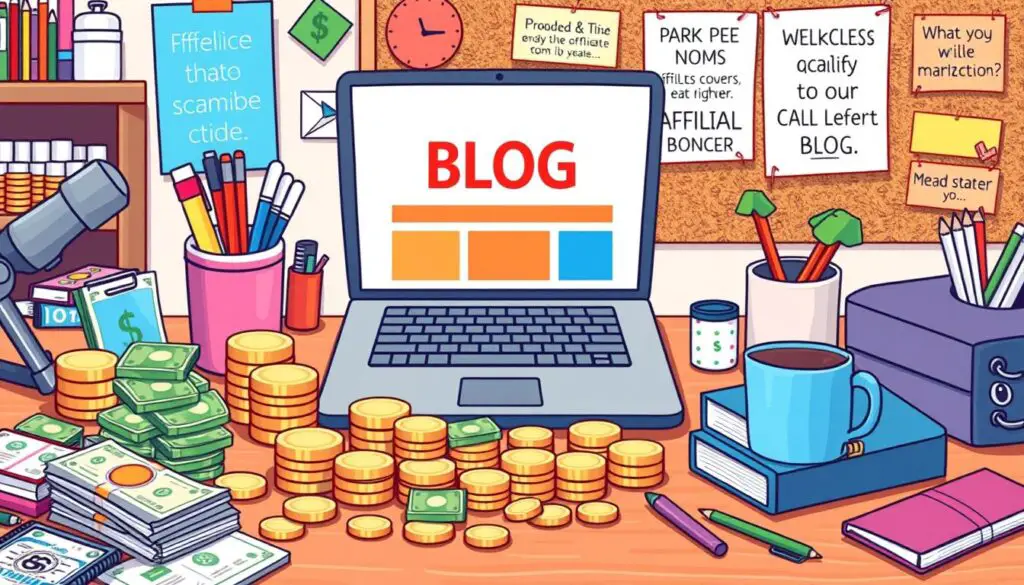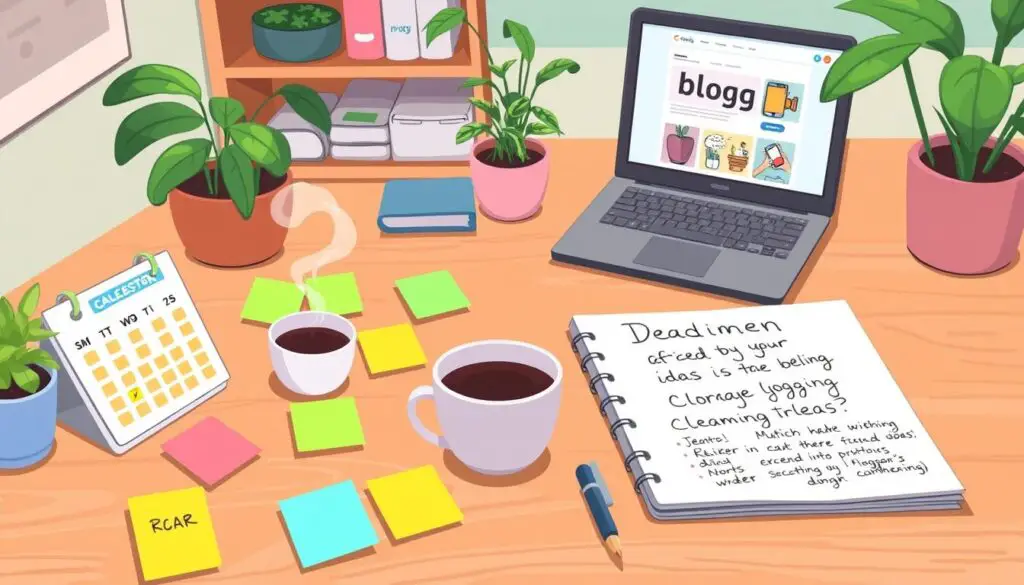In today’s world, blogging has grown from a hobby to a key way to share ideas. It needs smart planning, creativity, and technical know-how. Good bloggers know it’s not just about writing. It’s about making connections, sharing knowledge, and building online communities.
Modern blogging is all about a complete approach. Whether you’re an entrepreneur, a professional, or a writer, getting good at blogging can open many doors. Blogs are great for showing who you are and for marketing, reaching people all over the world.
Learning the best ways to write for blogs can really boost your online presence. This guide will cover key strategies, from making content to engaging with readers. It will help you build a strong and impactful blog.
Key Takeaways
- Blogging is a strategic digital communication method
- Effective blogs require creativity and technical skills
- Blogs can support personal and professional growth
- Content quality trumps quantity
- Consistent practice leads to blogging expertise
Understanding the Fundamentals of Blog Writing
Successful blogging needs a deep grasp of content creation. It’s not just about writing. It’s about making content that grabs and teaches readers.
Good blogging starts with knowing the basics. These basics turn simple text into engaging digital content. Writers must find ways to connect with their audience.
Key Components of a Successful Blog Post
Every great blog post has key parts:
- Attention-grabbing headline
- Clear, concise introduction
- Structured content with subheadings
- Engaging and informative body
- Strong, actionable conclusion
Basic Writing Principles for Bloggers
Bloggers need to know certain writing tricks:
- Use active voice
- Write short, easy-to-read paragraphs
- Make your content easy to scan
- Keep a friendly tone
“Great blogging is about connecting with readers through authentic, valuable content.”
Understanding Your Target Audience
Knowing your audience is key in blogging. Successful bloggers create detailed profiles of their audience. This helps them plan their content.
| Audience Research Method | Key Insights Gained |
|---|---|
| Demographics Analysis | Age, location, income level |
| Social Media Monitoring | Interests, online behaviors |
| Survey and Feedback | Direct audience preferences |
By using these basic blogging tips, writers can make content that speaks to readers. This builds a loyal following.
Creating Compelling Blog Content That Converts
Making a problog that really speaks to readers is more than just writing well. It turns casual readers into active followers and potential buyers. This happens through smart communication.
“Great content is the best sales tool in the digital world.” – Marcus Sheridan
To create blog content that converts, writers need to focus on a few key strategies:
- Develop magnetic headlines that spark curiosity
- Address specific reader pain points
- Provide actionable solutions
- Create emotional connections
The secret to great blog content is knowing what your audience really needs. Each piece should give unique insights that turn reader problems into chances.
| Content Element | Conversion Impact |
|---|---|
| Clear Problem Statement | High Engagement |
| Personal storytelling | Strong Connection |
| Actionable Advice | Direct Value |
Strategically placed calls-to-action (CTAs) can turn informative content into powerful conversion tools. By guiding readers to a specific next step, blogs become more than just info. They become paths to solutions.
Successful problog writers know conversion isn’t about pushing hard sales. It’s about building trust, showing expertise, and giving real value to their audience.
Essential Tools and Platforms for Blogging Success
Starting a blog needs careful tool and platform choices. Great bloggers know the right tech makes their blog stand out.
Choosing the right blog platform is key. Each one has special features for different goals and audiences.
Popular Blogging Platforms Compared
- WordPress: Most versatile platform with extensive customization options
- Wix: Beginner-friendly with drag-and-drop design capabilities
- Medium: Perfect for writers seeking built-in audience engagement
- Squarespace: Ideal for visual creators and portfolio blogs
Must-Have Writing and Editing Tools
Creating great blog content is more than just being creative. Professional bloggers use advanced tools to improve their work:
- Grammarly: Advanced grammar and style checking
- Hemingway App: Clarity and readability optimization
- CoSchedule Headline Analyzer: Crafting compelling titles
Analytics and Tracking Software
Knowing how your blog is doing is key for growth. Analytics tools give insights into audience behavior and content success.
“Data transforms guesswork into strategic decision-making for bloggers.” – Digital Marketing Expert
Google Analytics is top for tracking blog performance. It offers detailed metrics to help creators understand their audience and improve content.
Mastering Blog Post Structure and Formatting
Writing great content is just the start. The way you structure and format your blog post is key. It helps keep readers interested and boosts your SEO. Professional bloggers know that how you present your content matters a lot.
- Use clear and descriptive subheadings
- Break text into short, digestible paragraphs
- Incorporate white space for visual breathing room
- Utilize bullet points and numbered lists
The best length for a blog post depends on what you’re writing about. Here’s a quick guide:
| Content Type | Recommended Length |
|---|---|
| News/Quick Updates | 300-500 words |
| How-to Guides | 1000-1500 words |
| In-depth Analysis | 1500-2500 words |
“Good formatting transforms complex information into an enjoyable reading experience.” – Digital Content Experts
Mobile optimization is a must for today’s bloggers. Make sure your content looks good on phones and tablets. Readability on all devices can really boost your blog’s user engagement and search rankings.
Creating a great blog post structure is an art. Each paragraph should flow smoothly. It should guide readers through your content clearly and with purpose.
SEO Strategies for Better Blog Visibility
To make a successful problog, you need to know about search engine optimization (SEO). It helps your content show up more in searches. Learning how to blog with SEO can really help your site rank higher and get more visitors.
Search engines like websites that are well-optimized. Bloggers should work on different SEO areas to get noticed online.
Keyword Research and Implementation
Good keyword research is key for SEO success. Bloggers should:
- Use tools like Google Keyword Planner
- Find long-tail keywords
- Look at search volume and competition
- Go for specific search terms
On-Page SEO Best Practices
Make your blog better with these on-page tips:
| SEO Element | Optimization Strategy |
|---|---|
| Title Tags | Put your main keyword in, keep it short |
| Meta Descriptions | Write catchy summaries with keywords |
| Header Tags | Use H1-H3 tags wisely with keywords |
| Internal Linking | Link to related content on your blog |
Link Building Strategies
Get good backlinks by:
- Guest posting on trusted sites
- Making content that people want to share
- Talking to industry influencers
- Joining online communities
“SEO is not about gaming the system, but about creating quality content that provides value to readers.” – Digital Marketing Expert
By using these SEO tips, bloggers can make their problog more visible. This will help attract more people who are interested in their howtocreateblog content.
Building a Consistent Blogging Schedule
Creating a consistent blog schedule is key to success in the artofblog world. Successful bloggers know that regular posts build trust with their audience. They also help improve their site’s visibility on search engines.
“Consistency is the key to turning your blog from a hobby into a powerful communication platform.” – Digital Marketing Expert
To make a good blog schedule, you need to plan well and stay committed. Bloggers should think about a few important things when setting their content rhythm.
- Assess your available time for content creation
- Define realistic posting frequencies
- Create an editorial content calendar
- Track audience engagement metrics
Professional bloggers suggest different posting frequencies based on your niche and resources:
| Blog Type | Recommended Frequency | Content Focus |
|---|---|---|
| Personal Blog | 1-2 posts per week | Narrative & Personal Insights |
| Professional/Business Blog | 2-4 posts per week | Industry Expertise |
| News/Tech Blog | 3-5 posts per week | Current Trends |
Pro tip: Batch write content during high-productivity periods to maintain your blog’s consistent publishing schedule.
Remember, quality is more important than quantity in blogging. Aim to create valuable, engaging content that your audience will love. Keep your publishing rhythm steady.
Engaging Your Audience Through Storytelling
Storytelling is a key tool for bloggers to connect with their readers. It turns simple content into engaging stories that touch people’s hearts.
Narrative Techniques for Bloggers
Good bloggers know storytelling is more than sharing facts. They use stories to take readers on a journey.
- Use personal anecdotes to illustrate key points
- Create vivid character descriptions
- Develop compelling story arcs
- Incorporate sensory details
“The most powerful person in the world is the storyteller.” – Steve Jobs
Creating Emotional Connections
Blogging is not just about writing well. It’s about making readers feel something real. True stories help bloggers connect with their audience on a deeper level.
- Share vulnerable moments
- Demonstrate empathy
- Use relatable experiences
- Highlight personal growth
Authentic storytelling in blogging creates a bridge between the writer’s experiences and the reader’s emotions, making content truly memorable.
Monetization Strategies for Your Blog

Creating a problog is more than sharing content. It’s about turning your passion into profit. Successful bloggers use strong monetization strategies that match their audience and niche.
Most bloggers start with a few key strategies:
- Affiliate Marketing: Recommend products and earn commissions
- Display Advertising: Integrate ads from networks like Google AdSense
- Sponsored Content: Partner with brands for dedicated posts
- Digital Product Creation: Develop online courses, ebooks, or templates
- Consulting Services: Offer personalized expertise in your niche
“The most successful blogs turn audience trust into sustainable income streams.”
Choosing the right monetization strategy is key. Not every method works for every blog. Look at your traffic, engagement, and reader demographics to find the best approach.
Digital products can be very profitable. By using your expertise, you can create income sources that grow over time. These don’t depend on just page views or ad clicks.
Always keep your authenticity. Your monetization efforts should improve, not disrupt, the reader’s experience. Content that is transparent and valuable builds lasting loyalty and income for your blog.
Visual Content Integration in Blog Posts
Visual content is key in today’s blog writing. It makes blogs engaging and helps share ideas fast. Good bloggers see images as more than just pictures; they’re powerful tools for communication.
Visuals turn simple blog posts into stories. They make text easier to read and help explain complex ideas. This makes reading more enjoyable for everyone.
Image Selection Strategies
Picking the right images is important. The art of blog suggests a few key points:
- Choose high-resolution, relevant images
- Ensure visual consistency with brand style
- Select images that complement written content
- Use authentic, original photography when possible
Image Optimization Techniques
Optimizing images is more than just picking pretty pictures. Bloggers need to think about how it works too.
| Optimization Technique | Impact |
|---|---|
| Compress Image Files | Reduces page load time |
| Add Alt Text | Improves SEO and accessibility |
| Use Descriptive Filenames | Enhances search engine understanding |
Creating Engaging Visual Assets
Infographics and custom graphics can make blog content stand out. Tools like Canva and Adobe Spark help bloggers create great visuals without needing design skills.
“A picture is worth a thousand words” – especially in digital content creation
By adding thoughtful visual content, bloggers can make ordinary posts into amazing reads. This grabs and keeps the audience’s attention.
Promoting Your Blog Across Social Media

Social media is a key tool for bloggers to grow their audience. It’s not just about sharing posts. A smart strategy is needed to make the most of it.
Here are some effective ways to promote your blog on social media:
- Create content that fits each social network’s style
- Make eye-catching graphics for your blog posts
- Use hashtags to make your content more visible
- Interact with your followers by commenting and chatting directly
“Your social media presence is an extension of your blogging brand – make it count!”
Each social platform has its own way of working. Instagram is all about visuals, while Twitter is for short, sharp messages. LinkedIn is for professional content, and Facebook is for in-depth discussions.
To really make an impact on social media, bloggers should:
- Post regularly to keep your audience engaged
- Use analytics to see how well your content is doing
- Try out different types of content to see what works best
- Share your content on multiple platforms
Pro tip: Always include a clear call-to-action that directs followers back to your original blog post.
Building an Email List Through Your Blog
Creating a strong email list is key for any problog strategy. Successful bloggers know that an active email list can turn casual readers into loyal followers. This can also lead to potential customers for your howtocreateblog venture.
Email marketing is a powerful tool for bloggers to connect with their audience. By using smart strategies, bloggers can build strong relationships. They can also drive consistent traffic to their sites.
Lead Magnet Creation Strategies
Effective lead magnets are the heart of growing your email list. These valuable resources encourage readers to give you their contact info.
- Create targeted downloadable resources like checklists
- Design exclusive mini-courses
- Develop comprehensive PDF guides
- Offer free email-only content
Email Marketing Best Practices
Successful email marketing needs a careful approach. It should respect subscriber preferences while delivering engaging content.
- Segment your email list
- Personalize email content
- Craft compelling subject lines
- Maintain consistent communication
“Your email list is not just a collection of addresses—it’s a community waiting to be nurtured.” – Digital Marketing Experts
By using these strategies, bloggers can turn their email list into a powerful tool. This tool supports the long-term growth of their blog.
Creating a Strong Blog Brand Identity

Making your blog stand out is key. It turns a simple blog into a memorable online spot. Bloggers know their brand is more than words. It’s a mix of looks and feelings.
Building a strong blog brand means:
- Creating a unique look
- Keeping a consistent voice
- Using recognizable designs
- Defining your blog’s values
“Your blog brand is your digital fingerprint – uniquely yours and instantly recognizable.”
Keeping your blog’s look the same is important. Designers say pick colors, fonts, and styles that show your blog’s personality. These signs help readers know it’s you, no matter where they see it.
| Branding Element | Strategic Importance |
|---|---|
| Color Palette | Creates emotional connection and visual recognition |
| Logo Design | Provides instant brand identification |
| Typography | Communicates blog’s personality and tone |
A strong blog brand is more than looks. Your writing should also be consistent. This way, casual readers become true followers of your blog.
Common Blogging Mistakes to Avoid
Every blogger faces challenges on their digital journey. Knowing and fixing common mistakes can turn an average blog into a standout. It attracts and keeps readers.
It’s key to know the pitfalls of blogging. Bloggers often fall into traps that harm their strategy and engagement with readers.
Technical Challenges in Blogging
Technical problems can hurt a blog’s performance and user experience. Successful bloggers focus on important technical areas:
- Slow website loading speeds
- Poor mobile responsiveness
- Inadequate website security
- Ineffective site navigation
Content Creation Errors
Content is the core of blogging. Steer clear of these common content mistakes to improve your strategy:
| Error | Impact | Solution |
|---|---|---|
| Inconsistent publishing | Reduces reader trust | Create a consistent content calendar |
| Neglecting audience engagement | Decreases reader interaction | Respond to comments and encourage discussion |
| Over-promotional content | Alienates potential readers | Focus on value-driven content |
“Great blogging is about connecting, not selling.” – Unknown Blogger
Successful bloggers keep learning and adapting. By understanding these mistakes, you can create a more engaging and strategic blog. It will resonate with your audience.
Conclusion
Mastering blogging takes dedication, strategy, and a love for learning. To succeed, you need to know how to create great content, use SEO, engage with your audience, and keep working on your online presence.
Using the strategies from this guide can make your blog stand out. Each tip, from telling stories to adding visuals, is key to creating a site that draws in readers and search engines.
Digital publishing is always changing. Successful bloggers stay up-to-date, improve their skills, and keep an eye on trends. Your blog should be fresh, try new things, and always offer value to your readers.
Blogging is both an art and a science. While knowing your tech is important, your unique voice and connection with readers are what truly set you apart. Keep exploring, be patient, and see each post as a chance to get better.
FAQ
What is the most important element of successful blogging?
The key to successful blogging is creating valuable content that your audience loves. You need to know what your readers want and give them something unique. Keep your writing engaging and focused on their needs or interests.
How often should I publish blog posts?
How often you post depends on your niche and how much time you have. Most bloggers aim for 1-4 posts a week. It’s better to post less often but make sure it’s good quality. Use an editorial calendar to stay on track.
What are the best platforms for starting a blog?
WordPress, Blogger, Medium, and Wix are top choices for starting a blog. WordPress is especially good because it’s flexible and has great SEO tools. Think about your skills, budget, and goals when picking a platform.
How can I monetize my blog?
You can make money through affiliate marketing, sponsored posts, ads, digital products, courses, or consulting. Choose what works best for your niche and audience. Build a loyal following first, then start making money.
What are the key elements of SEO for blogs?
Good SEO includes finding the right keywords, optimizing titles and descriptions, and creating valuable content. Use header tags, improve your site’s speed, get quality backlinks, and make sure it works on mobile. Focus on creating content that meets your readers’ needs.
How do I grow my blog’s audience?
To grow your audience, post great content regularly, use social media, guest post, and engage with other bloggers. Use email marketing, join online communities, and optimize your site for SEO. Always aim to provide value and connect with your readers.
What tools do professional bloggers use?
Pro bloggers use Google Analytics, Grammarly, Canva, SEMrush, Buffer, and WordPress plugins. Good tools can make your blog better and more efficient. Invest in quality tools to improve your blog.
How important is visual content in blogging?
Visual content is very important. It makes your blog more engaging, breaks up text, and helps explain things. Use high-quality images, infographics, videos, and graphics. Make sure all visuals are optimized for the web and include alt text.
What are common mistakes new bloggers should avoid?
Avoid posting inconsistently, ignoring your audience, and creating generic content. Don’t forget about SEO, defining your niche, proofreading, and promoting your content. Focus on providing unique value and improving your skills.
How long does it take to build a successful blog?
Building a successful blog takes 6-12 months of hard work. Success depends on your niche, content quality, promotion, and audience engagement. Stay patient, persistent, and always look for ways to improve.






